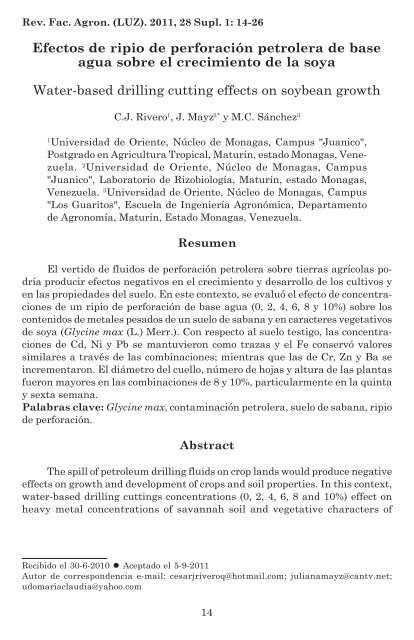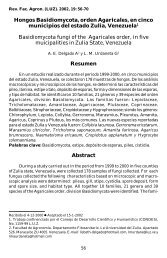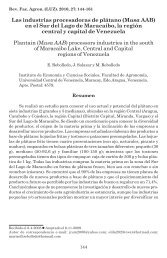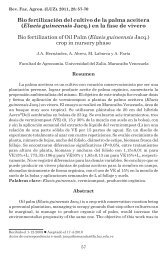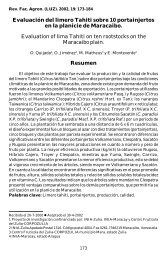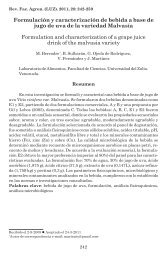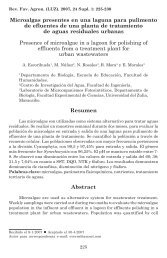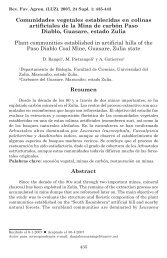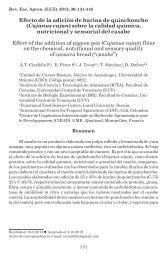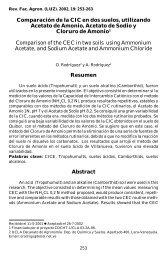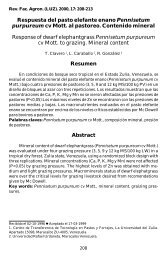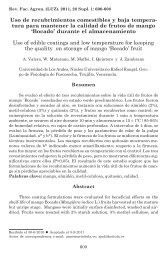Efectos de ripio de perforación petrolera de base agua sobre el ...
Efectos de ripio de perforación petrolera de base agua sobre el ...
Efectos de ripio de perforación petrolera de base agua sobre el ...
You also want an ePaper? Increase the reach of your titles
YUMPU automatically turns print PDFs into web optimized ePapers that Google loves.
Rev. Fac. Agron. (LUZ). 2011, 28 Supl. 1: 14-26<br />
<strong>Efectos</strong> <strong>de</strong> <strong>ripio</strong> <strong>de</strong> perforación <strong>petrolera</strong> <strong>de</strong> <strong>base</strong><br />
<strong>agua</strong> <strong>sobre</strong> <strong>el</strong> crecimiento <strong>de</strong> la soya<br />
Water-<strong>base</strong>d drilling cutting effects on soybean growth<br />
C.J. Rivero 1 , J. Mayz 2* y M.C. Sánchez 3<br />
1<br />
Universidad <strong>de</strong> Oriente, Núcleo <strong>de</strong> Monagas, Campus "Juanico",<br />
Postgrado en Agricultura Tropical, Maturín, estado Monagas, Venezu<strong>el</strong>a.<br />
2 Universidad <strong>de</strong> Oriente, Núcleo <strong>de</strong> Monagas, Campus<br />
"Juanico", Laboratorio <strong>de</strong> Rizobiología, Maturín, estado Monagas,<br />
Venezu<strong>el</strong>a. 3 Universidad <strong>de</strong> Oriente, Núcleo <strong>de</strong> Monagas, Campus<br />
"Los Guaritos", Escu<strong>el</strong>a <strong>de</strong> Ingeniería Agronómica, Departamento<br />
<strong>de</strong> Agronomía, Maturín, Estado Monagas, Venezu<strong>el</strong>a.<br />
Resumen<br />
El vertido <strong>de</strong> fluidos <strong>de</strong> perforación <strong>petrolera</strong> <strong>sobre</strong> tierras agrícolas podría<br />
producir efectos negativos en <strong>el</strong> crecimiento y <strong>de</strong>sarrollo <strong>de</strong> los cultivos y<br />
en las propieda<strong>de</strong>s <strong>de</strong>l su<strong>el</strong>o. En este contexto, se evaluó <strong>el</strong> efecto <strong>de</strong> concentraciones<br />
<strong>de</strong> un <strong>ripio</strong> <strong>de</strong> perforación <strong>de</strong> <strong>base</strong> <strong>agua</strong> (0, 2, 4, 6, 8 y 10%) <strong>sobre</strong> los<br />
contenidos <strong>de</strong> metales pesados <strong>de</strong> un su<strong>el</strong>o <strong>de</strong> sabana y en caracteres vegetativos<br />
<strong>de</strong> soya (Glycine max (L.) Merr.). Con respecto al su<strong>el</strong>o testigo, las concentraciones<br />
<strong>de</strong> Cd, Ni y Pb se mantuvieron como trazas y <strong>el</strong> Fe conservó valores<br />
similares a través <strong>de</strong> las combinaciones; mientras que las <strong>de</strong> Cr, Zn y Ba se<br />
incrementaron. El diámetro <strong>de</strong>l cu<strong>el</strong>lo, número <strong>de</strong> hojas y altura <strong>de</strong> las plantas<br />
fueron mayores en las combinaciones <strong>de</strong> 8 y 10%, particularmente en la quinta<br />
y sexta semana.<br />
Palabras clave: Glycine max, contaminación <strong>petrolera</strong>, su<strong>el</strong>o <strong>de</strong> sabana, <strong>ripio</strong><br />
<strong>de</strong> perforación.<br />
Abstract<br />
The spill of petroleum drilling fluids on crop lands would produce negative<br />
effects on growth and <strong>de</strong>v<strong>el</strong>opment of crops and soil properties. In this context,<br />
water-<strong>base</strong>d drilling cuttings concentrations (0, 2, 4, 6, 8 and 10%) effect on<br />
heavy metal concentrations of savannah soil and vegetative characters of<br />
Recibido <strong>el</strong> 30-6-2010 • Aceptado <strong>el</strong> 5-9-2011<br />
Autor <strong>de</strong> correspon<strong>de</strong>ncia e-mail: cesarjriveroq@hotmail.com; julianamayz@cantv.net;<br />
udomariaclaudia@yahoo.com<br />
14
Rev. Fac. Agron. (LUZ). 2011, 28 Supl. 1: 14-26<br />
soybean (Glycine max (L.) Merr.) were evaluated. Respect to control soil, Cd, Ni<br />
and Pb concentrations, steady as traces and Fe conserved similar values through<br />
out the combinations, while increasing Cr, Zn and Ba concentrations. Stem<br />
diameter, leaves number and plant height were higher at 8 and 10%<br />
combinations, particularly at weeks five and six.<br />
Key words: Glycine max, oil contamination, savannah soil, drilling cuttings.<br />
Introducción<br />
Un fluido <strong>de</strong> perforación es una<br />
mezcla <strong>de</strong> arcilla y productos químicos<br />
diluidos en <strong>agua</strong> o aceite, utilizado<br />
para enfriamiento, estabilización<br />
<strong>de</strong> las pare<strong>de</strong>s, s<strong>el</strong>lado <strong>de</strong> los poros y<br />
control <strong>de</strong> la presión <strong>de</strong>l pozo petrolero,<br />
lubricación <strong>de</strong> las tuberías y como<br />
medio <strong>de</strong> acumulación y arrastre <strong>de</strong><br />
la roca excavada o <strong>ripio</strong>s <strong>de</strong> perforación<br />
(Kisic et al., 2009). El fluido <strong>base</strong><br />
<strong>agua</strong> (±90%) es consi<strong>de</strong>rado<br />
ambientalmente amigable, cuyo uso<br />
es generalmente en las primeras secciones<br />
<strong>de</strong> los pozos <strong>de</strong> perforación, <strong>el</strong><br />
cual surgió por la necesidad <strong>de</strong> utilizar<br />
un fluido económico; sin embargo,<br />
presenta baja efectividad a altas<br />
temperaturas, en su<strong>el</strong>os inestables, en<br />
presencia <strong>de</strong> ángulos agudos <strong>de</strong> perforación<br />
y en su<strong>el</strong>os salinos. El fluido<br />
<strong>base</strong> aceite utiliza gasoil o aceites<br />
minerales y aparece en <strong>el</strong> año 1950<br />
para solventar los problemas <strong>de</strong> los<br />
lodos <strong>base</strong> <strong>agua</strong>, siendo utilizado en<br />
sus inicios dies<strong>el</strong> o gasoil como la <strong>base</strong><br />
aceitosa; producen menores cantida<strong>de</strong>s<br />
<strong>de</strong> <strong>de</strong>secho, al permitir ser reciclados<br />
o reutilizados <strong>de</strong>spués <strong>de</strong> su<br />
tratamiento, siendo baja<br />
bio<strong>de</strong>gradabilidad y alta toxicidad,<br />
por lo que su disposición es costosa.<br />
Es por <strong>el</strong>lo que nació una segunda<br />
generación los llamados <strong>de</strong> baja toxicidad,<br />
en los cuales se han disminuido<br />
a un mínimo la cantidad <strong>de</strong> com-<br />
Introduction<br />
A perforation fluids is a mixture<br />
of clay and chemical products water<br />
or oil diluted, used for freezing or<br />
heating, walls stabilization, pores<br />
sailed and control of petroleum<br />
pressure, pipes lubrication and as<br />
accumulation and dragging of dig rock<br />
or drilling cutting (Kisic et al., 2009).<br />
The water-<strong>base</strong>d fluid (±90%) is<br />
consi<strong>de</strong>red like friendly from the<br />
environmental point of view,<br />
generally used in first sections of oil<br />
w<strong>el</strong>ls, which comes by the necessity<br />
of using an economic fluid; however,<br />
shows low effectiveness to high<br />
temperatures, on instable soils, in<br />
presence of drilling acute angles and<br />
en saline soils. The oil-<strong>base</strong>d fluid use<br />
dies<strong>el</strong> or mineral oils and appears at<br />
1950 year to solvent problems of<br />
water-<strong>base</strong> muds, being used in its<br />
dies<strong>el</strong> beginnings like the oil <strong>base</strong>;<br />
produce lower waste quantities, by<br />
permitting to be recycled or re used<br />
after its treatment, being low<br />
bio<strong>de</strong>gradability and high toxicity,<br />
thus, its disposition is expensive.<br />
Therefore, a second generation was<br />
emerged, those called low toxicity,<br />
where the quantity of aromatic<br />
polycycle compound and olefinic<br />
chains have been reduced to a<br />
minimum that gave dies<strong>el</strong> its toxicity<br />
characteristics (Berry, 2009). Once<br />
drilling of a w<strong>el</strong>l finished, frequently<br />
15
Rivero et al.<br />
puestos policíclicos aromáticos y ca<strong>de</strong>nas<br />
olefinicas que le dan las características<br />
<strong>de</strong> toxicidad al dies<strong>el</strong> (Berry,<br />
2009). Una vez completada la perforación<br />
<strong>de</strong> un pozo, a menudo los <strong>ripio</strong>s<br />
son vertidos <strong>sobre</strong> <strong>el</strong> su<strong>el</strong>o, muchas<br />
veces <strong>sobre</strong> tierras <strong>de</strong> vocación<br />
agrícola, produciendo cambios en las<br />
propieda<strong>de</strong>s físicas, químicas y<br />
microbiológicas, <strong>de</strong> tal manera, que<br />
solventar a<strong>de</strong>cuadamente <strong>el</strong> impacto<br />
ambiental, se encuentra <strong>de</strong>ntro <strong>de</strong> las<br />
priorida<strong>de</strong>s fundamentales <strong>de</strong> la industria<br />
<strong>petrolera</strong>, tanto en <strong>el</strong> ámbito<br />
nacional como internacional (Venezu<strong>el</strong>a,<br />
1998; Kisic et al., 2009).<br />
Son muchos los estudios que<br />
muestran <strong>el</strong> impacto negativo <strong>de</strong> los<br />
<strong>ripio</strong>s <strong>de</strong> perforación <strong>sobre</strong> <strong>el</strong> crecimiento<br />
y <strong>el</strong> <strong>de</strong>sarrollo <strong>de</strong> las plantas<br />
y en las propieda<strong>de</strong>s <strong>de</strong>l su<strong>el</strong>o<br />
(Zvomuya et al., 2008); sin embargo<br />
existen discrepancias entre los estudios,<br />
explicadas por las variaciones en<br />
los contenidos <strong>de</strong> metales pesados en<br />
los tipos <strong>de</strong> <strong>ripio</strong>s <strong>de</strong> perforación y a<br />
las concentraciones usadas (Bau<strong>de</strong>r et<br />
al., 2005).<br />
Los propósitos <strong>de</strong>l presente estudio<br />
incluyen: <strong>de</strong>terminar <strong>el</strong> efecto<br />
<strong>de</strong> la aplicación <strong>de</strong> <strong>ripio</strong> petrolero <strong>base</strong><br />
<strong>agua</strong> <strong>sobre</strong> la concentración <strong>de</strong> metales<br />
pesados en un su<strong>el</strong>o <strong>de</strong> sabana y<br />
evaluar los caracteres vegetativos en<br />
soya cultivada en diferentes concentraciones<br />
<strong>de</strong> este <strong>ripio</strong>.<br />
Materiales y métodos<br />
El experimento se instaló en inverna<strong>de</strong>ro<br />
(Universidad <strong>de</strong> Oriente,<br />
Campus "Juanico", Maturín: 10º44’<br />
LN y 63º23’ LO, 90 msnm, Estado<br />
Monagas, Venezu<strong>el</strong>a), bajo <strong>el</strong> diseño<br />
the cuttings are spilled on soil, many<br />
times on agricultural lands, producing<br />
changes in physical, chemical and<br />
microbiological properties, such a way<br />
that to solve the environmental<br />
impact properly, is taken as a part of<br />
essential priorities of oil industry,<br />
both national and international (Venezu<strong>el</strong>a,<br />
1998; Kisic et al., 2009).<br />
There are a lot of studies that<br />
shows the negative impact of drilling<br />
cuttings on behavior and <strong>de</strong>v<strong>el</strong>opment<br />
of plants and on soil properties<br />
(Zvomuya et al., 2008); neverth<strong>el</strong>ess,<br />
there are discrepancies between the<br />
studies explained by the variations in<br />
contents of heavy metals in types of<br />
drilling cuttings and to the<br />
concentrations used (Bau<strong>de</strong>r et al.,<br />
2005).<br />
The purposes of this research<br />
inclu<strong>de</strong>s: to <strong>de</strong>termine the effect of<br />
water-<strong>base</strong>d petroleum cutting<br />
application on heavy metals<br />
concentration in a savanna soil and<br />
to evaluate the vegetative characters<br />
in soybean cultivated at different<br />
cutting concentrations.<br />
Materials and methods<br />
The experiment was carried out<br />
in glass house (Orient University,<br />
Campus "Juanico", Maturín: 10º44’<br />
NL and 63º23’ WL, 90 masl, Monagas<br />
state, Venezu<strong>el</strong>a), un<strong>de</strong>r at random<br />
<strong>de</strong>sign with four replications, with<br />
savanna soil, Oxicplinthustulf type,<br />
coming from Savanna Experimental<br />
Station, Orient University, Campus<br />
"Jusepín", Jusepín, Monagas state,<br />
where several water-<strong>base</strong>d drilling<br />
cuttings concentrations were applied<br />
(0, 2, 4, 6, 8 and 10%), for a total of<br />
16
Rev. Fac. Agron. (LUZ). 2011, 28 Supl. 1: 14-26<br />
<strong>de</strong> bloques al azar con cuatro repeticiones,<br />
con su<strong>el</strong>o <strong>de</strong> sabana <strong>de</strong> tipo<br />
Oxicplinthustulf proveniente <strong>de</strong> la<br />
Estación Experimental <strong>de</strong> Sabana <strong>de</strong><br />
la Universidad <strong>de</strong> Oriente, Campus<br />
"Jusepín", Jusepín, Estado Monagas,<br />
al cual se le aplicaron varias concentraciones<br />
<strong>de</strong> <strong>ripio</strong> <strong>de</strong> perforación <strong>de</strong><br />
<strong>base</strong> <strong>agua</strong> (0, 2, 4, 6, 8 y 10%), para<br />
un total <strong>de</strong> seis tratamientos. Tanto<br />
<strong>el</strong> su<strong>el</strong>o <strong>de</strong> sabana como <strong>el</strong> <strong>ripio</strong> petrolero<br />
<strong>de</strong> la empresa Venline (El<br />
Furrial, Estado Monagas) se analizaron<br />
para fertilidad, micro<strong>el</strong>ementos,<br />
salinidad y metales; a<strong>de</strong>más, se <strong>de</strong>terminaron<br />
metales pesados en las<br />
mezclas y en <strong>el</strong> follaje <strong>de</strong> las plantas<br />
a los 47 días <strong>de</strong>spués <strong>de</strong> la siembra.<br />
Los análisis se realizaron en <strong>el</strong> Laboratorio<br />
<strong>de</strong> Servicios Agroambientales<br />
<strong>de</strong> la Universidad <strong>de</strong> Oriente<br />
(LABSEA, UDO).<br />
Las semillas <strong>de</strong> soya <strong>de</strong> la variedad<br />
Samba (Empresa GROSOSCA,<br />
Estado Monagas) se <strong>de</strong>sinfectaron con<br />
una solución <strong>de</strong> cloro al 10%, durante<br />
3 min, luego se lavaron siete veces con<br />
<strong>agua</strong> <strong>de</strong>stilada estéril, <strong>de</strong>jándolas remojar<br />
por una hora en <strong>el</strong> <strong>agua</strong> <strong>de</strong> lavado<br />
final. Se sembraron a razón <strong>de</strong><br />
tres semillas por bolsa <strong>de</strong> polietileno<br />
<strong>de</strong> 3 kg <strong>de</strong> capacidad, cargadas con <strong>el</strong><br />
su<strong>el</strong>o previamente mezclado con la<br />
concentración <strong>de</strong> <strong>ripio</strong> <strong>de</strong> perforación<br />
al tratamiento correspondiente, inoculándose<br />
justo antes <strong>de</strong> la siembra<br />
con Bradyrhizobium japonicum<br />
(BIOAGRO 10), <strong>el</strong> cual se preparó e<br />
incorporó a las semillas <strong>de</strong> acuerdo<br />
con las recomendaciones. La fertilización<br />
se aplicó al momento <strong>de</strong> la siembra:<br />
95,2 mg <strong>de</strong> (NH 4<br />
) 2<br />
SO 4<br />
, 93,1 mg<br />
<strong>de</strong> KH 2<br />
PO 4<br />
y 20,9 mg <strong>de</strong> KCl por bolsa.<br />
El riego se realizó cada 3 días (300-<br />
six treatments. Both savanna soil and<br />
petroleum cutting, were supplied by<br />
"Venline" enterprise ("El Furrial",<br />
Monagas state), they were assessed<br />
for fertility, micro <strong>el</strong>ements, salinity<br />
and metals; also, heavy metals were<br />
<strong>de</strong>termined on mixtures and on plants<br />
foliage at 47 days after sowing. The<br />
analyses were accomplished in the<br />
Agro Environmental Services<br />
Laboratory of the Orient University<br />
(LABSEA, UDO).<br />
Soybean seeds of ‘Samba’ variety<br />
(GROSOSCA enterprise, Monagas<br />
state) were disinfected with a chlori<strong>de</strong><br />
solution to 10%, during 3 min, after that,<br />
they were seven times washed with<br />
sterile distilled water, leaving them<br />
soaked during one hour in water of final<br />
wash. Three seeds were sowed by each<br />
polyethylene bag with capacity of 3 kg,<br />
charged with soil previously mixed with<br />
drilling cutting concentration to the<br />
correspon<strong>de</strong>nt treatment, being<br />
inoculated just before sowing with<br />
Bradyrhizobium japonicum (BIOAGRO<br />
10), which was prepared and ad<strong>de</strong>d to<br />
seeds according to recommendations.<br />
Fertilization was applied to the<br />
treatment at the moment of sowing: 95.2<br />
mg of (NH 4<br />
) 2<br />
SO 4<br />
, 93.1 mg <strong>de</strong> KH 2<br />
PO 4<br />
and 20.9 mg of KCl by bag. Irrigation<br />
was done each 3 days (300-400 mL of<br />
running water by bag) to cover plants<br />
requirement and control of samples was<br />
manually accomplished.<br />
The height, neck diameter and<br />
numebr of leaves by sprout, were<br />
weekly evaluated from second until<br />
sixth week (flowering beginning) after<br />
sowing. The analysis of variance was<br />
done to the <strong>de</strong>sign and means were<br />
compared through the minimum<br />
significant difference (P≤0.05).<br />
17
Rivero et al.<br />
400 mL <strong>de</strong> <strong>agua</strong> corriente por bolsa)<br />
para cubrir los requerimientos <strong>de</strong> las<br />
plantas y <strong>el</strong> control <strong>de</strong> malezas se efectuó<br />
<strong>de</strong> forma manual.<br />
Se evaluaron altura, diámetro<br />
<strong>de</strong>l cu<strong>el</strong>lo y número <strong>de</strong> hojas <strong>de</strong>l vástago,<br />
semanalmente a partir <strong>de</strong> la segunda<br />
semana y hasta la sexta semana<br />
(inicio <strong>de</strong> la floración) <strong>de</strong>spués <strong>de</strong><br />
la siembra. Se realizó <strong>el</strong> análisis <strong>de</strong><br />
varianza correspondiente al diseño y<br />
se compararon las medias mediante<br />
la mínima diferencia significativa<br />
(P≤0,05).<br />
Resultados y discusión<br />
Características físicoquímicas<br />
<strong>de</strong> los sustratos<br />
El su<strong>el</strong>o <strong>de</strong> sabana (testigo) presentó<br />
clase textural areno-francosa,<br />
pH ligeramente ácido, muy baja concentración<br />
<strong>de</strong> fósforo, potasio y materia<br />
orgánica; niv<strong>el</strong>es medios <strong>de</strong> calcio,<br />
magnesio, capacidad <strong>de</strong> intercambio<br />
catiónico efectiva (CICE) y trazas <strong>de</strong><br />
aluminio. Los micro<strong>el</strong>ementos zinc,<br />
cobre y manganeso se encontraron por<br />
<strong>de</strong>bajo <strong>de</strong> los valores <strong>de</strong> referencia y<br />
los metales pesados en trazas, exceptuando<br />
<strong>el</strong> hierro total. El análisis <strong>de</strong><br />
salinidad mostró valores para la<br />
conductividad <strong>el</strong>éctrica (CE) y la r<strong>el</strong>ación<br />
<strong>de</strong> absorción <strong>de</strong> sodio ( RAS) por<br />
<strong>de</strong>bajo <strong>de</strong> los niv<strong>el</strong>es normales (cuadro<br />
1).<br />
El <strong>ripio</strong> <strong>de</strong> perforación <strong>base</strong> <strong>agua</strong><br />
mostró clase textural franco-arcilloarenosa,<br />
probablemente por la cantidad<br />
<strong>de</strong> arcilla que se adiciona durante<br />
<strong>el</strong> proceso <strong>de</strong> perforación <strong>de</strong>l pozo<br />
petrolero, pH muy alcalino, bajas concentraciones<br />
<strong>de</strong> fósforo y materia orgánica,<br />
y sodio no <strong>de</strong>tectable, en con-<br />
Results and dicussion<br />
Physical-chemcal<br />
characteristics of substrates<br />
The savanna soil (control)<br />
showed textural sandy loam class,<br />
lightly acid pH, very low phosphorous,<br />
potassium and organic matter<br />
concentration; medium lev<strong>el</strong>s of<br />
calcium, magnesium, effective<br />
cationic exchange capacity (ECEC)<br />
and aluminum traces. The micro<br />
<strong>el</strong>ements zinc, copper and manganese<br />
were b<strong>el</strong>ow reference values and<br />
heavy metals in traces, except the total<br />
iron. The salinity analysis showed<br />
values for <strong>el</strong>ectrical conductivity (EC)<br />
and sodium absorption r<strong>el</strong>ation (SAR)<br />
b<strong>el</strong>ow normal lev<strong>el</strong>s (table 1).<br />
The water-<strong>base</strong>d drilling cutting<br />
showed sandy-clay-loam class, probable<br />
because the clay quantity ad<strong>de</strong>d<br />
during oil w<strong>el</strong>l drilling process, very<br />
alkaline pH, low phosphorous and<br />
organic matter concentrations, and<br />
un<strong>de</strong>tectable sodium, unlike high<br />
lev<strong>el</strong>s of calcium and potassium and<br />
of micro <strong>el</strong>ements zinc, copper, iron<br />
and manganese, being greater than<br />
in soil. Heavy metals were found in<br />
very low concentrations, with<br />
exception of total iron, above the<br />
permissible limit. The salinity<br />
analysis revealed mo<strong>de</strong>rate EC and<br />
SAR very close to the low permitted<br />
limit (table 1). It is evi<strong>de</strong>nt that both<br />
macro and micro <strong>el</strong>ements, were<br />
found in higher concentrations in<br />
water-<strong>base</strong>d drilling cutting than in<br />
savanna soil, which shows that drillin<br />
cutting could be used as fertilizer<br />
through the incorporation on soil in<br />
low concentrations and with frequent<br />
physical and chemical analysis;<br />
18
Rev. Fac. Agron. (LUZ). 2011, 28 Supl. 1: 14-26<br />
Cuadro 1. Análisis <strong>de</strong> fertilidad, micro<strong>el</strong>ementos, salinidad y metales pesados realizado al su<strong>el</strong>o <strong>de</strong> sabana<br />
y al <strong>ripio</strong> <strong>de</strong> perforación <strong>de</strong> <strong>base</strong> <strong>agua</strong>, antes <strong>de</strong> la siembra.<br />
Table 1. Analysis of fertility, micro-<strong>el</strong>ements, salinity and heavy metals done in the soils of Savannah<br />
and perforation grav<strong>el</strong>s of water <strong>base</strong>ment before the sow.<br />
Fertilidad<br />
I<strong>de</strong>ntificación Unidad Valores <strong>de</strong> referencia 1 Determinación<br />
Bajo Medio Alto Su<strong>el</strong>o 2 Ripio 3<br />
pH 5,2 9,0<br />
P mg kg -1 11-30 >30 1,97 2,30<br />
Ca me 100g -1<br />
<strong>de</strong> su<strong>el</strong>o 0,50-1 >1 0,88 3,16<br />
Mg 0,25-0,65 >0,65 0,43 1,12<br />
K 0,13-0,26 >0,26 0,02 0,70<br />
Al 0,25-0,50 >0,50 Trazas Trazas<br />
H 0,13 0,13<br />
CICE 1,46 5,11<br />
Saturación <strong>de</strong> Al % 0,00 0,00<br />
Materia Orgánica 1,5-3,0 >3,0 0,70 1,47<br />
Textura<br />
Arcilla % 7,2 29,2<br />
Clase Areno-francosa<br />
Micro<strong>el</strong>ementos<br />
Zn mg kg -1 1,5-2,5 >2,5 0,88 8,64<br />
Cu 0,8-1,2 >1,2 Trazas 0,84<br />
Mn >1,5 >1,5-2,5 >2,5 0,6 37,10<br />
Fe 7,0-11,0 >11,0 20,40 97,60<br />
1 Laboratorio <strong>de</strong> servicios agroambientales (LABSEA), Universidad <strong>de</strong> Oriente, Núcleo <strong>de</strong> Monagas, Maturín.<br />
2 Su<strong>el</strong>o<br />
<strong>de</strong> sabana tipo Oxicplinthustulf. 3 Ripio <strong>de</strong> perforación <strong>de</strong> <strong>base</strong> <strong>agua</strong>.<br />
19
Rivero et al.<br />
Cuadro 1. Análisis <strong>de</strong> fertilidad, micro<strong>el</strong>ementos, salinidad y metales pesados realizado al su<strong>el</strong>o <strong>de</strong> sabana<br />
y al <strong>ripio</strong> <strong>de</strong> perforación <strong>de</strong> <strong>base</strong> <strong>agua</strong>, antes <strong>de</strong> la siembra (Continuación).<br />
Table 1. Analysis of fertility, micro-<strong>el</strong>ements, salinity and heavy metals done in the soils of Savannah<br />
and perforation grav<strong>el</strong>s of water <strong>base</strong>ment before the sow (Continuation).<br />
Salinidad<br />
Su<strong>el</strong>o 2 Ripio 3<br />
Niv<strong>el</strong>es Determinación Límite Determinación<br />
normales<br />
Sulfatos me L -1 >5,2 0,106 1,83<br />
Carbonatos Trazas 0,216<br />
Bicarbonatos 1,0 0,136 0,508<br />
Na 0,061 6,69<br />
RAS >15,0 0,13
Rev. Fac. Agron. (LUZ). 2011, 28 Supl. 1: 14-26<br />
traposición con los niv<strong>el</strong>es altos <strong>de</strong><br />
calcio y potasio y <strong>de</strong> los<br />
micro<strong>el</strong>ementos zinc, cobre, manganeso<br />
y hierro, siendo mucho mayores que<br />
en <strong>el</strong> su<strong>el</strong>o. Los metales pesados se<br />
encontraron en concentraciones muy<br />
bajas, a excepción <strong>de</strong>l hierro total, que<br />
se halló por encima <strong>de</strong>l límite permisible.<br />
El análisis <strong>de</strong> salinidad rev<strong>el</strong>ó<br />
mo<strong>de</strong>rada CE y RAS muy cercana al<br />
límite menor permitido (cuadro 1). Es<br />
evi<strong>de</strong>nte que tanto los macro como los<br />
micro<strong>el</strong>ementos se encontraron en<br />
mayores concentraciones en <strong>el</strong> <strong>ripio</strong><br />
<strong>de</strong> perforación <strong>de</strong> <strong>base</strong> <strong>agua</strong> que en <strong>el</strong><br />
su<strong>el</strong>o <strong>de</strong> sabana, lo cual indica que <strong>el</strong><br />
<strong>ripio</strong> <strong>de</strong> perforación pudiera ser utilizado<br />
como fertilizante a través <strong>de</strong> su<br />
incorporación en <strong>el</strong> su<strong>el</strong>o en bajas concentraciones<br />
y con análisis físico-químicos<br />
frecuentes; sin embargo, algunas<br />
características tales como <strong>el</strong> pH,<br />
la cantidad <strong>de</strong> arcilla y la CICE pudieran<br />
afectar negativa o positivamente<br />
la absorción <strong>de</strong> los<br />
nutrimentos. El <strong>ripio</strong> <strong>de</strong> perforación<br />
concretamente presenta pH muy<br />
alcalino, porcentaje <strong>de</strong> arcilla <strong>de</strong> 29%<br />
y CICE efectiva <strong>de</strong> 5,11, factores que<br />
podrían significar la fijación o <strong>el</strong> predominio<br />
<strong>de</strong> formas no disponibles e<br />
intercambiables <strong>de</strong> los <strong>el</strong>ementos<br />
(Roca et al., 2007), cuyos efectos negativos<br />
se trasladarían al su<strong>el</strong>o con <strong>el</strong><br />
cual se combine, sin <strong>de</strong>jar <strong>de</strong> enfatizar<br />
que también lo serían los efectos<br />
favorables.<br />
Evaluación <strong>de</strong> caracteres<br />
vegetativos en soya<br />
Los análisis <strong>de</strong> varianza para <strong>el</strong><br />
diámetro <strong>de</strong>l cu<strong>el</strong>lo <strong>de</strong> las plantas <strong>de</strong><br />
soya exhibieron para las dos semanas<br />
<strong>de</strong>spués <strong>de</strong> la siembra la ausencia<br />
<strong>de</strong> diferencias estadísticamente<br />
however, some characteristics such as<br />
pH, clay quantity and ECEC could<br />
affect negativ<strong>el</strong>y or positiv<strong>el</strong>y the<br />
absorption of nutrients. The drilling<br />
cutting shows very alkaline pH, clay<br />
percentage of 29% and effective ECEC<br />
of 5.11, factors signifying the fixation<br />
or predominance of unavailable and<br />
exchangeable ways <strong>el</strong>ements (Roca et<br />
al., 2007), with negative effects for soil<br />
in combination with, without leaving<br />
to emphasize the favorable effects.<br />
Evaluation of vegetative<br />
characteristics in soybean<br />
The analysis of variance for neck<br />
diameter of soybean plants showed<br />
for the two weeks after sowing, the<br />
absence of differences statistically<br />
significant (F=1.63) between<br />
concentrations of water-<strong>base</strong>d drilling<br />
cuttings, unlike results of weeks<br />
three, four, five and six where<br />
differences were observed between<br />
treatments applied (F2.90, 2.95, 7.50<br />
and 6.38 respectiv<strong>el</strong>y). The results of<br />
weeks three to six after sowing point<br />
at a favorable effect of all the water<strong>base</strong>d<br />
drilling cuttings concentrations<br />
on thickness of sprout, particularly of<br />
8 and 10% concentrations, which not<br />
differs statistically from control to<br />
week five, and on week six where<br />
disparity with the rest of treatments<br />
was marked (0.221 cm, both mixtures)<br />
(table 2).<br />
The analysis of variance for<br />
plant height showed significant<br />
differences between treatments, only<br />
for the fifth and sixth growing week<br />
(F=4.71 and 4.76); neverth<strong>el</strong>ess, the<br />
positive effect of incorporation of<br />
water-<strong>base</strong>d drilling cutting was<br />
observed from second week, with a<br />
ten<strong>de</strong>ncy to increase from<br />
21
Rivero et al.<br />
significativas (F=1,63) entre las concentraciones<br />
<strong>de</strong> <strong>ripio</strong> <strong>de</strong> perforación<br />
<strong>de</strong> <strong>base</strong> <strong>agua</strong> usadas, contrastando<br />
con los resultados <strong>de</strong> las semanas<br />
tres, cuatro, cinco y seis don<strong>de</strong> se<br />
presentaron diferencias entre los tratamientos<br />
aplicados (F=2,90, 2,95,<br />
7,50 y 6,38 respectivamente). Los<br />
resultados <strong>de</strong> las semanas tres a seis<br />
<strong>de</strong>spués <strong>de</strong> la siembra apuntan hacia<br />
un efecto favorable <strong>de</strong> todas las<br />
concentraciones <strong>de</strong>l <strong>ripio</strong> <strong>de</strong> perforación<br />
<strong>de</strong> <strong>base</strong> <strong>agua</strong> <strong>sobre</strong> <strong>el</strong> grosor<br />
<strong>de</strong>l vástago, particularmente <strong>de</strong> las<br />
concentraciones <strong>de</strong> 8 y 10%, las cuales<br />
no se diferencian estadísticamente<br />
<strong>de</strong>l testigo hasta la semana<br />
cinco, siendo en la semana seis don<strong>de</strong><br />
la <strong>de</strong>sigualdad con <strong>el</strong> resto <strong>de</strong> los<br />
tratamientos estuvo marcada (0,221<br />
cm, para ambas mezclas) (cuadro 2).<br />
Los análisis <strong>de</strong> varianza para la<br />
altura <strong>de</strong> las plantas mostraron diferencias<br />
significativas entre los tratamientos,<br />
sólo para la quinta y sexta<br />
semana <strong>de</strong> crecimiento (F=4,71 y<br />
4,76); sin embargo, <strong>el</strong> efecto positivo<br />
<strong>de</strong> la incorporación <strong>de</strong>l <strong>ripio</strong> <strong>de</strong> perforación<br />
<strong>de</strong> <strong>base</strong> <strong>agua</strong> se observó a<br />
partir <strong>de</strong> la segunda semana, con una<br />
ten<strong>de</strong>ncia a incrementar a partir <strong>de</strong><br />
la concentración <strong>de</strong> 4%, y con un marcado<br />
efecto favorable <strong>de</strong> la concentración<br />
<strong>de</strong> 8% en la quinta y sexta semana,<br />
con valores (15,550 y 25,558<br />
cm <strong>de</strong> altura) significativamente<br />
iguales a los resultantes con la concentración<br />
<strong>de</strong> 10% (15,083 y 24,022<br />
cm) pero diferentes a los valores encontrados<br />
en <strong>el</strong> testigo (9,902 y<br />
15,839 cm) (cuadro 2).<br />
Similarmente a la altura <strong>de</strong> las<br />
plantas, <strong>el</strong> número <strong>de</strong> hojas por planta<br />
estuvo influenciado por las conconcentration<br />
of 4%, and with a strong<br />
favorable effect of concentration of 8%<br />
in fifth and sixth week, with values<br />
(15,550 and 25,558 cm height)<br />
significant equal to those resultant<br />
with concentration of 10% (15,083 and<br />
24,022 cm) but different to values<br />
found in control (9,902 and 15,839 cm)<br />
(table 2).<br />
Like plants height, the number<br />
of leaves was influenced by<br />
concentrations of water-<strong>base</strong>d drilling<br />
cutting applied for the fifth and sixth<br />
growing week (F=5.25 and 3.44), with<br />
ten<strong>de</strong>ncy to increase from<br />
concentration of 4% during periods<br />
evaluated, being the best response for<br />
the concentration of 8%, being<br />
obtained the higher values on fifth<br />
(11.029 leaves plant -1 ) and sixth week<br />
(15.111 leaves plant -1 ), similar to<br />
those resultant with concentration of<br />
10% (9.889 and 13.945 leaves plant -1 )<br />
and different to control (5.750 and<br />
10.250 leaves plant -1 ) (table 2).<br />
In general, the application of<br />
water-<strong>base</strong>d drilling cutting to<br />
savanna soil improved the soybean<br />
growth ‘Samba’ variety, measured<br />
through the stem diameter, number<br />
of leaves and plants height. This<br />
consequence can be caused by any of<br />
components of drilling cutting or to<br />
the increase of micronutrients or<br />
macronutrients. The attributes of<br />
water-<strong>base</strong>d drilling cuttings have<br />
been reported by Bau<strong>de</strong>r et al. (1999),<br />
who found in sorghum cv. DeKalb<br />
STC-6 that from application of 15 g<br />
kg -1 of soil, the dry matter yi<strong>el</strong>d<br />
increased. Bau<strong>de</strong>r et al. (2005) found<br />
in wheat cv. TAM 107 that application<br />
of 17-94 Mg ha -1 increased grains<br />
production in comparison to control.<br />
22
Rev. Fac. Agron. (LUZ). 2011, 28 Supl. 1: 14-26<br />
Cuadro 2. Diámetro <strong>de</strong>l cu<strong>el</strong>lo, altura y número <strong>de</strong> hojas <strong>de</strong> plantas <strong>de</strong><br />
soya cultivadas en varias concentraciones <strong>de</strong> <strong>ripio</strong> <strong>de</strong><br />
perforación <strong>de</strong> <strong>base</strong> <strong>agua</strong>.<br />
Table 2. Diameter of neck, height and leaves number of soybean plants<br />
cultivated at several concentrations of water-<strong>base</strong>d drilling<br />
cutting.<br />
Concentración <strong>de</strong><br />
<strong>ripio</strong> <strong>de</strong> perforación<br />
<strong>base</strong> <strong>agua</strong> (%) Diámetro <strong>de</strong>l cu<strong>el</strong>lo (cm)<br />
Semanas <strong>de</strong>spués <strong>de</strong> la siembra<br />
2 3 4 5 6<br />
0 0,110 0,114 ab 0,125 ab 0,104 a 0,138 bc<br />
2 0,090 0,072 b 0,069 b 0,058 c 0,072 c<br />
4 0,164 0,138 a 0,133 ab 0,161 ab 0,188 ab<br />
6 0,139 0,135 ab 0,145 a 0,152 ab 0,175 ab<br />
8 0,178 0,174 a 0,181 a 0,196 a 0,221 a<br />
10 0,169 0,161 a 0,175 a 0,186 a 0,221 a<br />
Concentración <strong>de</strong><br />
<strong>ripio</strong> <strong>de</strong> perforación<br />
<strong>base</strong> <strong>agua</strong> (%) Altura (cm)<br />
Semanas <strong>de</strong>spués <strong>de</strong> la siembra<br />
2 3 4 5 6<br />
0 7,375 8,707 8,492 9,902 bc 15,839 bc<br />
2 4,832 5,116 6,616 4,966 c 8,730 c<br />
4 8,739 9,409 12,308 13,731 ab 22,656 ab<br />
6 7,672 8,784 11,319 13,183 ab 22,908 abc<br />
8 0,579 10,639 13,522 15,550 a 25,558 a<br />
10 9,575 10,636 13,459 15,083 ab 24,022 ab<br />
Concentración <strong>de</strong><br />
<strong>ripio</strong> <strong>de</strong> perforación<br />
<strong>base</strong> <strong>agua</strong> (%) Número <strong>de</strong> hojas por planta<br />
Semanas <strong>de</strong>spués <strong>de</strong> la siembra<br />
2 3 4 5 6<br />
0 2,919 5,083 6,750 5,750 bc 10,250 bc<br />
2 2,111 3,389 4,472 3,472 c 7,667 c<br />
4 3,333 5,389 7,889 8,306 ab 12,750 ab<br />
6 2,888 4,972 7,389 8,583 ab 10,834 abc<br />
8 3,500 6,389 8,972 11,029 a 15,111 a<br />
10 3,936 6,083 8,667 9,889 a 13,945 ab<br />
Letras distintas indican promedios estadísticamente diferentes (Prueba <strong>de</strong> la mínima diferencia<br />
significativa, P≤0,05).<br />
23
Rivero et al.<br />
centraciones <strong>de</strong> <strong>ripio</strong> <strong>de</strong> perforación<br />
<strong>de</strong> <strong>base</strong> <strong>agua</strong> aplicadas para la quinta<br />
y sexta semana <strong>de</strong> crecimiento<br />
(F=5,25 y 3,44), con ten<strong>de</strong>ncia a aumentar<br />
a partir <strong>de</strong> la concentración<br />
<strong>de</strong> 4% durante los períodos evaluados,<br />
siendo la mejor respuesta para<br />
la concentración <strong>de</strong> 8%,<br />
obteniéndose los mayores valores en<br />
la quinta (11,029 hojas planta -1 ) y<br />
sexta semana (15,111 hojas planta -1 ),<br />
similares a los resultantes con la<br />
concentración <strong>de</strong> 10% (9,889 y<br />
13,945 hojas planta -1 ) y diferentes al<br />
testigo (5,750 y 10,250 hojas planta -1-1 )<br />
(cuadro 2).<br />
En general la aplicación <strong>de</strong>l <strong>ripio</strong><br />
<strong>de</strong> perforación <strong>base</strong> <strong>agua</strong> al su<strong>el</strong>o<br />
<strong>de</strong> sabana mejoró <strong>el</strong> crecimiento <strong>de</strong> la<br />
soya variedad Samba, medido a través<br />
<strong>de</strong>l diámetro <strong>de</strong>l tallo, número <strong>de</strong><br />
hojas y altura <strong>de</strong> las plantas. Esta consecuencia<br />
pue<strong>de</strong> <strong>de</strong>berse a alguno <strong>de</strong><br />
los componentes <strong>de</strong>l <strong>ripio</strong> <strong>de</strong> perforación<br />
o al incremento <strong>de</strong> los micronutrientes<br />
o <strong>de</strong> los macronutrientes.<br />
Los atributos <strong>de</strong>l <strong>ripio</strong> <strong>de</strong> perforación<br />
<strong>de</strong> <strong>base</strong> <strong>agua</strong> han sido reportados por<br />
Bau<strong>de</strong>r et al. (1999), quienes encontraron<br />
en sorgo cv. DeKalb STC-6 que<br />
a partir <strong>de</strong> la aplicación <strong>de</strong> 15 g kg -1<br />
<strong>de</strong> su<strong>el</strong>o se maximizó <strong>el</strong> rendimiento<br />
en materia seca. Bau<strong>de</strong>r et al. (2005)<br />
hallaron en <strong>el</strong> trigo cv. TAM 107 que<br />
la aplicación <strong>de</strong> 17-94 Mg ha -1<br />
incrementó la producción <strong>de</strong> granos<br />
en comparación con los testigos. El<br />
efecto beneficioso ha sido consi<strong>de</strong>rado<br />
por algunos investigadores como<br />
una consecuencia <strong>de</strong> la mayor disponibilidad<br />
<strong>de</strong> macro y micronutrientes,<br />
particularmente hierro y zinc (N<strong>el</strong>son<br />
et al., 1984; Bau<strong>de</strong>r et al., 1999; Kisic<br />
et al., 2009).<br />
The beneficial effect have been<br />
consi<strong>de</strong>red by some researchers as a<br />
consequence of higher availability of<br />
macro and micronutrients, especially<br />
iron and zinc (N<strong>el</strong>son et al., 1984;<br />
Bau<strong>de</strong>r et al., 1999; Kisic et al., 2009).<br />
Heavy metals in mixtures of<br />
water-<strong>base</strong>d drilling cuttings and<br />
savanna soil-<strong>base</strong>d, and in<br />
soybean foliage<br />
In savanna soil type<br />
Oxicplinthustulf, the cadmium,<br />
nick<strong>el</strong>, iron and lead remained invariable<br />
through different water-<strong>base</strong>d<br />
drilling cutting used, only increasing<br />
those of barium, when concentration<br />
increased from 2 to 10%; and<br />
chromium and zinc remained almost<br />
equal. It is possible to <strong>de</strong>tach that<br />
when mixing savanna soil and water<strong>base</strong>d<br />
drilling cutting, an increase of<br />
barium, chromium and zinc occurred,<br />
but any case surpassing limits<br />
established or concentrations found in<br />
drilling cutting (tables 1 and 3). The<br />
increase of barium content in<br />
mixtures of 2 to 10% drilling cutting<br />
(78 until 268 mg kg -1 ) did not reflect<br />
in foliage concentrations from fourth<br />
week. The chromium and zinc<br />
remained similar to the savanna soil,<br />
such a way that the increase produced<br />
with the addition of drilling cutting<br />
could not be available for absorption;<br />
unlike cadmium, nick<strong>el</strong> and lead did<br />
not how changes in concentration (traces),<br />
keeping values similar to those<br />
found in control and in mixtures<br />
(tables 1 and 3).<br />
Conclusions<br />
The content of heavy metals (Pb,<br />
Ni, Ba, Cd, Cr, Zn and Fe) in<br />
24
Rev. Fac. Agron. (LUZ). 2011, 28 Supl. 1: 14-26<br />
Metales pesados en las mezclas<br />
<strong>de</strong> <strong>ripio</strong> <strong>de</strong> perforación <strong>de</strong><br />
<strong>base</strong> <strong>agua</strong> y su<strong>el</strong>o <strong>de</strong> sabana, y en<br />
<strong>el</strong> follaje <strong>de</strong> soya<br />
En <strong>el</strong> su<strong>el</strong>o <strong>de</strong> sabana tipo<br />
Oxicplinthustulf los valores <strong>de</strong><br />
cadmio, níqu<strong>el</strong>, hierro y plomo se conservaron<br />
invariables a través <strong>de</strong> las<br />
diferentes concentraciones <strong>de</strong> <strong>ripio</strong> <strong>de</strong><br />
perforación <strong>de</strong> <strong>base</strong> <strong>agua</strong> usadas,<br />
incrementándose sólo la <strong>de</strong> bario, a<br />
medida que se aumentó <strong>de</strong> la concentración<br />
<strong>de</strong> 2 a 10%; y <strong>el</strong> cromo y zinc<br />
se mantuvieron casi iguales. Es <strong>de</strong> hacer<br />
notar que al mezclar su<strong>el</strong>o <strong>de</strong> sabana<br />
y <strong>ripio</strong> <strong>de</strong> perforación <strong>de</strong> <strong>base</strong><br />
<strong>agua</strong> se produjo un aumento <strong>de</strong> bario,<br />
cromo y zinc, pero en ningún caso<br />
llegaron a <strong>sobre</strong>pasar los límites establecidos<br />
o las concentraciones encontradas<br />
en <strong>el</strong> <strong>ripio</strong> <strong>de</strong> perforación<br />
(cuadros 1 y 3). El ascenso <strong>de</strong>l contecombinations<br />
water-<strong>base</strong>d drilling<br />
cutting and in savanna soil (2-10%)<br />
did not exceed concentrations in the<br />
original drilling cutting, nor limits<br />
established like permissible. The neck<br />
diameter, the number of leaves and<br />
plants height were higher in water<strong>base</strong>d<br />
drilling cutting concentrations<br />
of 8 and 10%, especially on fifth and<br />
six week.<br />
End of english version<br />
nido <strong>de</strong> bario en las mezclas <strong>de</strong> 2 a<br />
10% <strong>de</strong> <strong>ripio</strong> <strong>de</strong> perforación (78 hasta<br />
268 mg kg -1 ) no se reflejó en las concentraciones<br />
<strong>de</strong>l follaje a partir <strong>de</strong> la<br />
cuarta semana. El cromo y <strong>el</strong> zinc permanecieron<br />
similares al su<strong>el</strong>o <strong>de</strong> sabana,<br />
<strong>de</strong> manera que <strong>el</strong> incremento<br />
que se produjo con la adición <strong>de</strong> <strong>ripio</strong><br />
Cuadro 3. Concentraciones <strong>de</strong> metales pesados en las combinaciones<br />
<strong>de</strong> <strong>ripio</strong> <strong>de</strong> perforación <strong>de</strong> <strong>base</strong> <strong>agua</strong>-su<strong>el</strong>o (rs) y en <strong>el</strong> follaje<br />
(f) <strong>de</strong> plantas <strong>de</strong> soya cultivadas en estas mezclas durante<br />
seis semanas.<br />
Table 3. Concentrations of heavy metals in combinations of water-soil<br />
<strong>base</strong>d of drilling cuttings (rs) and on foliage (f) of soybean<br />
plants cultivated in these mixtures during six weeks.<br />
ET Concentración <strong>de</strong> <strong>ripio</strong> <strong>de</strong> perforación <strong>de</strong> <strong>base</strong> <strong>agua</strong> (%)<br />
0 2 4 6 8 10<br />
S f rs f rs f rs f rs f rs f<br />
Ba T 45,0 78,0 192,0 162,5 150,0 163,0 168,0 271,5 198,0 268,0 170,0<br />
Cd T T T T T T T T T T T T<br />
Cr T T 6,5 T 6,5 T 7,0 T 7,0 T 6,5 T<br />
Fe 4.415,0 116,0 3.615,0 166,0 3.880,0 103,0 4.360,0 110,0 4.360,0 92,0 3.725,0 167,0<br />
Ni T T T T T T T T T T T T<br />
Pb T T T T T T T T T T T T<br />
Zn T 83,0 16,0 84,0 17,0 70,0 18,0 83,0 22,0 67.0 16,5 81,0<br />
ET=Elemento total (mg kg -1 ).<br />
S=Su<strong>el</strong>o <strong>de</strong> sabana <strong>de</strong> tipo Oxicplinthustulf.<br />
T=Trazas.<br />
25
Rivero et al.<br />
<strong>de</strong> perforación podría no estar disponible<br />
para absorción; en contraste, <strong>el</strong><br />
cadmio, <strong>el</strong> níqu<strong>el</strong> y <strong>el</strong> plomo no mostraron<br />
cambios en la concentración<br />
(trazas), manteniendo valores semejantes<br />
a los encontrados en <strong>el</strong> testigo<br />
y en las mezclas (cuadros 1 y 3).<br />
Conclusiones<br />
Los contenidos <strong>de</strong> metales pesados<br />
(Pb, Ni, Ba, Cd, Cr, Zn y Fe) en<br />
las combinaciones <strong>ripio</strong> <strong>de</strong> perforación<br />
<strong>de</strong> <strong>base</strong> <strong>agua</strong> y en <strong>el</strong> su<strong>el</strong>o <strong>de</strong> sabana<br />
(2-10%) no excedieron las concentraciones<br />
en <strong>el</strong> <strong>ripio</strong> <strong>de</strong> perforación original,<br />
ni los límites establecidos como<br />
permisibles. El diámetro <strong>de</strong>l cu<strong>el</strong>lo, <strong>el</strong><br />
número <strong>de</strong> hojas y la altura <strong>de</strong> las<br />
plantas fueron mayores en las concentraciones<br />
<strong>de</strong> <strong>ripio</strong> <strong>de</strong> perforación <strong>de</strong><br />
<strong>base</strong> <strong>agua</strong> <strong>de</strong> 8 y 10%, particularmente<br />
en la quinta y sexta semana.<br />
Literatura citada<br />
Bau<strong>de</strong>r, T. A., K. A. Barbarick, J. A.<br />
Ippolito, J. F. Shanahan y P. D.<br />
Ayers. 2005. Soil properties<br />
affecting wheat yi<strong>el</strong>ds following<br />
drilling-fluid application. J.<br />
Environ. Qual. 34(5):1687–1696.<br />
Berry, J. 2009. Drilling fluid properties<br />
& functions. CETCO, USA. 7 p.<br />
Kisic, I., S. Mesic, F. Basic, L. Brkic, M.<br />
Mesic, G. Durn, Z. Zgor<strong>el</strong>ec y L.<br />
Bertovic. 2009. The effect of<br />
drilling fluids and cru<strong>de</strong> oil on<br />
some chemical characteristics of<br />
soil and crops. Geo<strong>de</strong>rma. 149(3-<br />
4):209-216.<br />
N<strong>el</strong>son, D.W., S.L. Liu y L.E. Sommers.<br />
1984. Extractability and plant<br />
uptake of trace <strong>el</strong>ements from<br />
drilling fluids. J. Environ. Qual.<br />
13(4):562-566.<br />
Roca, N., M.B. Pazos y J. Bech. 2007.<br />
Disponibilidad <strong>de</strong> cobre, hierro,<br />
manganeso, zinc en su<strong>el</strong>os <strong>de</strong>l NO<br />
argentino. Cien. Su<strong>el</strong>o 25 (1):31-<br />
42.<br />
Venezu<strong>el</strong>a. 1998. Manejo <strong>de</strong> los <strong>de</strong>sechos<br />
p<strong>el</strong>igrosos <strong>de</strong> activida<strong>de</strong>s <strong>de</strong><br />
exploración y producción <strong>de</strong><br />
petróleo. Gaceta Oficial <strong>de</strong> la<br />
República <strong>de</strong> Venezu<strong>el</strong>a No. 5.245<br />
Extraordinaria. Caracas.<br />
Zvomuya, F., F.J. Larney, S.M. McGinn,<br />
A. F. Olson y W. D. Willms. 2008.<br />
Surface albedo and soil heat flux<br />
changes following drilling mud<br />
application to a semiarid, mixedgrass<br />
prairie. Soil Sci. Soc. Am. J.<br />
72:1217-1225.<br />
Bau<strong>de</strong>r, T.A., K.A. Barbarick, J.F.<br />
Shanahan P.D. Ayers y P.L.<br />
Chapman. 1999. Drilling fluid<br />
effects on crop growth and iron and<br />
zinc availability. J. Environ. Qual.<br />
28(3):744-749.<br />
26


